|
|
|
|
Products mentioned in this Article
--None--
|
|
|
|
|
|
|
|
|
 |
|
|
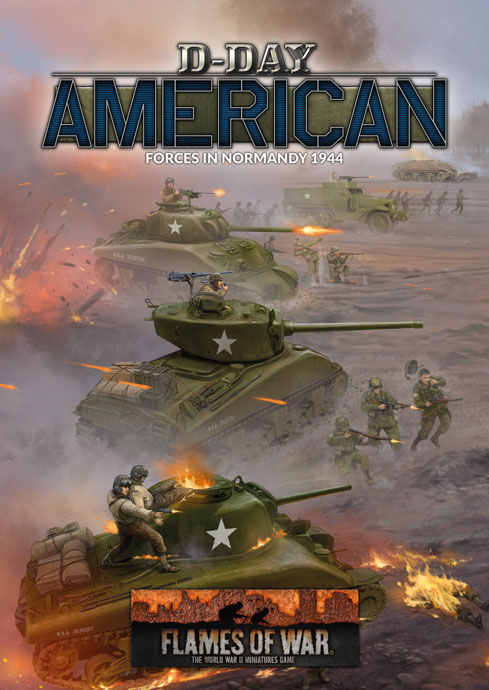 |
Indianhead:
The US 2nd Infantry Division in France June-September 1944.
The 2nd Infantry Division was first formed in September 1917 during World War One. It was unique in that it comprised of both Army and Marine regiments. During the war it had two Marine commanders, the only time in American military history that a Marine commanded an Army division. They fought bravely at the battles of Belleau Wood and Château- Thierry helping to break the four-year long stalemate. They went on to participate in the Meuse-Argonne Offensive, which helped bring the war to an end in late 1918.
It was during World War One that the division received its insignia, an Indian’s head on a white star. The symbol came from one of the division’s truck drivers who had painted it on his truck. From there is was adopted as the divisional symbol and remains as the 2nd “Indianheads” Infantry Division’s insignia to this day.
Check out the Indianhead SMG Platoon here...
|
Between the wars the division remained active, stationed in Texas. The division was used as a test bed for new innovations in warfare. They led the other American divisions in anti-tank tactics and air mobile concepts and became the first American division to be reorganised with the modern ‘triangular’ formation with three separate regiments, giving them greater flexibility on the battlefield.
The division tested their special training in the Louisiana Manoeuvres, a giant full-scale wargame played by the US Army in August-September 1941. As a member of the “Blue Army” the 2nd Infantry Division performed well, helping their side to victory.
After the Louisiana Manoeuvres, the division was transferred to the state of Wisconsin where the division trained for four months in winter warfare. In 1943 the division was sent to England to prepare for the invasion of France.
The division, under the command of Major General Walter Robertson, landed on Omaha Beach on 7 June (D+1) 1944
and immediately set to work securing the beach, mopping up German resistance, and liberating the town of Trévières before moving inland. |
Saint-Lô
The division took up the position in the front line between the US 1st and 29th Infantry Divisions as the US Army pushed out from the beach. With the beachhead secure, the division turned inland and fought through the bloody battles in northern Normandy’s hedgerows.
In the American sector, the battles took the US V Corps to the city of Saint-Lô. This city was important because it was positioned on a critical road and railroad hub. It also had two bridges over the Vire River. If Saint-Lô could be captured, the Americans could break out of the bloody hedgerows and into the open ground beyond. The 1st, 2nd, and 29th Infantry Divisions led the way.
The Indianheads were tasked with capturing the vital Hill 192, the highest elevation in the Saint-Lô area. The Germans were using it to observe American targets for their artillery. Several attempts had been made to secure the hill, but the Indianheads were pushed back each time. |
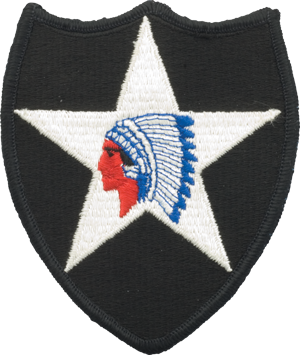 |
Finally on 11 July, Colonel Ralph Zwicker’s 38th Infantry Regiment assaulted the hill backed by two Sherman medium tank companies, one Stuart light tank company, and some engineers.
The 2nd Infantry Division’s artillery opened up on the hill, thrashing the defenders hapless enough not to be in their foxholes with over 45 tons of high explosives. When the dust settled the first of the Indianheads charged into the assault. German mortars opened up and took a toll on the American soldiers and the attack stalled. The Shermans went to work pounding the hillside relentlessly as the American infantry bounced back into action.
The fight for the hill continued to be tough. At one location, named “Kraut Corner”, German paratroopers fired on the Americans from an elaborate system of concealed dugouts and tunnels. Frustrated by these crafty defenders, the Indianheads called up Sherman tanks fitted with bulldozer blades and simply buried the Germans—soldiers, weapons, and all—and then moved on to Hill 192. Very few, prisoners were taken at Kraut Corner, such was the intensity of the fight. |
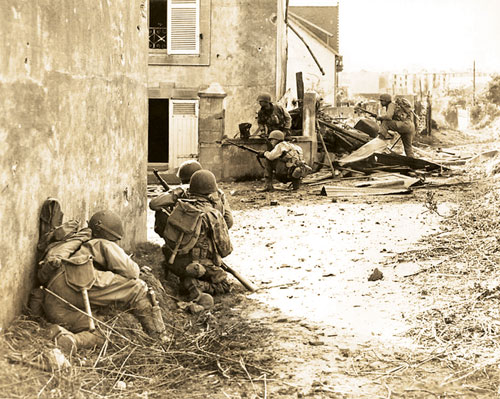 |
The 2nd Infantry Division pushed through the defenders and reached the hill’s summit around noon. They had achieved success through close cooperation between tanks, infantry, engineers, and artillery.
With Hill 192 secure, the 2nd Infantry Division settled into the defensive along with the rest of the V Corps until 26 July. The American breakout during Operation Cobra propelled them across northern France. The Indianheads crossed the Vire River and liberated Tinchebray on 15 August 1944.
After the battles around Saint-Lô, the 2nd and 29th Infantry Division were transferred west to Brittany as a part of the newly formed VIII Corps. Their job was to capture the deep water port of Brest in what would become a very difficult and bloody fight. |
Brittany
During the breakout of Operation Cobra, two American armoured divisions crashed into Brittany and raced for the
seaport of Brest. The US VIII Corps was then organised to tackle the city itself with three infantry divisions: the 29th from the north, the 8th in the centre and the 2nd in the east. The Indianheads were also tasked with clearing out the Daoulas Peninsula to the south.
Task Force B
The Daoulas Peninsula struck out into the ocean just south of Brest and contained high ground overlooking the city, which made it a prized objective for American artillery. The Germans also realised this and heavily fortified the area.
The 2nd Infantry Division assembled Task Force B to capture the peninsula. The force was built around the 38th Infantry Regiment with support from a company of Sherman tanks, a company of tank destroyers, three battalions of artillery, and Task Force A, a cavalry and tank destroyer unit. |
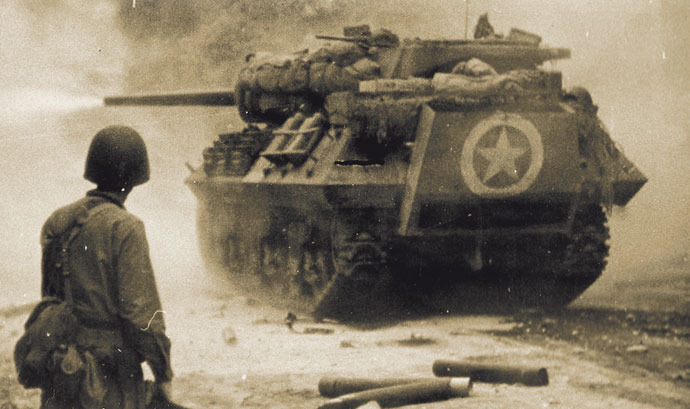 |
On 22 August Task Force B moved to hit its first objective, the heavily fortified Hill 154. The Indianheads used the tactics they had learned in the hedgerows of Normandy. The men crawled flat on their stomachs slowly and deliberately toward the bunkers using each and every bush and rock to conceal their movement. Suddenly, they leapt up and overran the German bunkers with flamethrowers and hand grenades. The surprise was so complete that one German taken prisoner said, “I knew you were coming but I couldn’t do anything. I could see no one to shoot. The first American soldier I saw was the one who captured me!”
With the fall of Hill 154, German resistance on the peninsula fell apart. The Indianheads then set up Task Force X (later known as Ivory X), an artillery group consisting of 57 .50 cal machine-guns, 12 tank destroyers, and eight 40mm anti-aircraft guns. From their positions Ivory X was able to hit the Germans from behind. They kept up a hail of fire supporting the Indianheads during the assaults on Brest itself. |
Hill 105
On September 1 the 23rd Infantry Regiment of the 2nd Infantry Division attacked Hill 105. Capturing this hill was the key to folding the German defences on the outside of the city. Companies A and C of the 5th Rangers Battalion were attached to help them with this task.
The Indianheads and the Rangers assaulted with the help of Ivory X which pelted the defenders from behind with .50 calibre ammunition. The Americans poured around and over the top, capturing the important hill. |
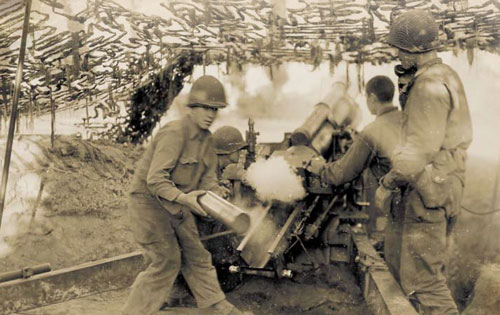 |
City Fighting
With Hill 105 captured, the 2nd advanced to the city itself. The journey was painfully slow, as the Germans had seeded the approaches with thousands of mines and booby traps, including rigged naval shells and torpedoes. Amongst these the Germans had machine-gun emplacements, but the ever resourceful Indianheads called upon M12 155mm self-propelled guns to blast them apart at close range.
When the Indianheads reached the city they fought street-by-street eliminating each German strongpoint one by one. |
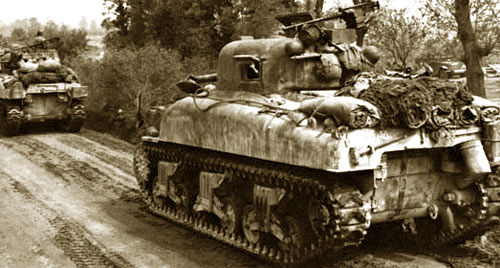 |
The advance was slow, but progress was being made, until the Indianheads hit the city wall on 16 September.
The Wall
Brest’s city wall was built in medieval days. It was 35 feet (11m) tall and 60 feet (18m) wide in some places, making it impervious to artillery fire. The Germans had also cleared everything in front of the wall out to 300 yards, giving them excellent fields of fire. |
| The ancient wall frustrated the Indianheads until a patrol found a neglected part of the wall that was only eight feet (2.4m) tall and only a foot (30cm) thick. The Indianheads blasted through and got behind the last of the German lines. |
Soon the Indianheads met up with their comrades from the 29th Infantry Division and the two pressed home the attack. After sporadic fighting the Germans finally ran up the white flag. General Robertson accepted the surrender of Fortress Brest on 18 September 1944, only 39 days after Hitler had demanded the city resist for three months.
The 2nd Infantry Division left Brittany as an extremely well organised and highly professional unit. During the battle, the Indianheads had suffered 2,314 casualties, but captured over 13,000 prisoners, nearly half of the total taken at Brest.
You can field Indianhead: The US 2nd Infantry Division in France June-September 1944 Using D-Day: American Rifle Company )page 42 and the 2nd Infantry Division Indian Head command card which allows you to arm your Rifle Platoon with Thompson SMGs. |
 |
Last Updated On Wednesday, May 27, 2020 by Wayne at Battlefront
|
|
|